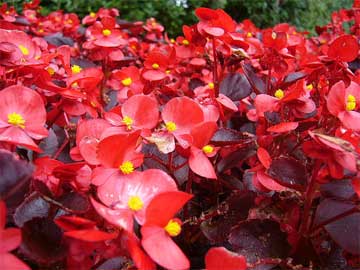Easy to grow, petite and beautiful, these are adjectives that describe begonias. Wax begonias (not to be confused with tuberous begonias, which are normally grown in flower pots and planters) are a perennial flower that can be started from plugs in the spring or planted in the fall for winter flowering in areas of the country that don’t experience prolonged freezing temperatures (they can handle a light frost). In the northern regions of the country they’re planted as annuals, although they can be brought inside in the fall and overwintered as a houseplant.
Begonias are easy to care for and will give you nonstop flowering throughout the winter months. They bloom in red, scarlet, rose, pink and white. Their waxy leaves are attractive and come in green, bronze or brownish.
This variety of begonia can be potted up at any time and brought inside and grown as a houseplant. Cut back one third of the plant before potting it up and fertilize lightly with a houseplant fertilizer.
When to Plant
Plant begonias in the spring time as they become available in the garden centers (and after the last hard frost in the northern climates). You can also plant them in the fall in parts of the country where it doesn’t freeze over the winter.

Where to Plant Begonias
Wax begonias do best in part shade, particularly during the summer months, but will do well in full sun when planted over the winter as a perennial. Use these compact plants in borders and/or to mass plant in a flower bed. For best results plant begonias in rich, moist, well-drained soil. Moderate light is best for most begonias though many tolerate low light. Bright light will damage most begonias, though it does not burn many cultivars of wax begonia.
Planting Depth for Begonias
Wax begonias are considered a bedding plant. They are normally sold in cell packs and should be planted to the depth they grew in the container; in other words, bury the root ball it is growing in. You don’t need to break the root ball apart before planting. The 5-IN-1(shown right) with its’ adapter plates, can quickly dig planting holes for bulbs and annuals 2″, 4″ and even 6″ deep…all from a comfortable, standing position.
Spacing Begonias
Space begonias about 4-6 inches apart.
Planting Begonias
Digging the planting hole:

Step 1
Use the metal adapter plates provided to set the desired depth of the hole, from 2″, 4″ or 6″ deep holes. Select the adapter plate which corresponds to the size of the cell in which your Begonias were sold. For most common sized cells, you’ll likely use either the 2″ or 4″ adapter.
Step 2
(Step, twist & pull) Step down on the foot pegs until the adapter plate bottoms out against the soil. Give the 5-IN-1 a slight twist to break the plug of soil free and pull up on the handle bars. There! You’ve just dug your planting hole. If a larger diameter hole is needed, take several “bites” with the 5-IN-1 until you’ve created the desired size (see video for demonstration).
Plant the Begonias
Remove the Begonias from its’ growing cell and place into planting hole. Use amended soil to fill in around the Begonias, pressing down gently. Remember to water well after planting.
Watering Begonias
Begonias should be kept moist and for many the medium should be allowed to dry between each watering. Although some will tolerate having wet soil, most do not. Avoid water with high salt content, especially sodium, as this will burn the plants and damage the very fine roots.
Feeding / Fertilizing Begonias
Wax begonias will require only a light feeding of an all purpose (10-10-10) fertilizer right after planting. Mulching around the plants with aged compost or well rotted manure will achieve the same effect as a light feeding of fertilizer, and will also protect the plant from a light freeze.
Disease and Pest Problems
Begonias are susceptible to powdery mildew and gray mold, both fungus diseases that can be controlled with a fungicide, such as Captan or a copper based fungicide, such as Soap Shield from Gardens Alive. Proper spacing and good air circulation are good preventative measures.
Mealy bugs can also be a problem. Check your plants before they leave the nursery for infestation as mealy bugs are hard to eradicate. According to the American Begonia Society “The easiest and least toxic mealy bug killer is plain rubbing alcohol. For a badly infested plant you can put the alcohol in a spray bottle and spray the entire plant. It won’t harm the plant, but avoid spraying the soil directly as a precaution.”
Neil Moran is a horticulturist and author of three books on gardening. He is also the creator and author of the garden blog North Country Gardener
Additional Resources for Begonias
American Begonia Society
Be sure to check out the helpful information on our website, including other uses for the ProPlugger including:

